| Report Type | Full |
| Peak(s) |
Quandary Peak - 14,272 feet |
| Date Posted | 08/18/2023 |
| Modified | 09/11/2023 |
| Date Climbed | 03/29/2023 |
| Author | ECF55 |
| Quandary in the Snow - Lessons Learned from a Cold Weather 14er Newb |
|---|
|
Quandary Peak in the Early Spring Snow - Thoughts for Winter Beginners 29 March 2023 (Monday) Hike Times: 5:55am - 12:40pm MDT (6h 45min hike duration) Distance/Elevation: 6.84 miles / 3,281 ft (MapMyRun estimates) Mountain Conditions: Full snow coverage. Deep snow below treeline (massive trench on the trail), windswept snowfields with drifts above treeline. Some snow softening by noon that caused significant post-holing for hikers without flotation. Weather Conditions: Absolutely gorgeous early spring conditions. Moderately cold conditions at trailhead (24°F); temperature on summit ~20°F. Clear and very bright. Increasingly windy above treeline on the ridge with powder blasting. Gusts up to ~30mph, but generally less. Crowds: There were very few hikers on the mountain in the pre-dawn hours, but crowds increased significantly on my descent (~30+ hikers). What is there to say about hiking Quandary Peak that hasn't already been said? Quandary East Ridge is a stately ramp of a mountain in the Tenmile range between Breckenridge and Fairplay. It is a much more modest hike than those in the Sawatch with a straightforward Class 1 trail, but it's consistently steep. The views on the top are outstanding. Over the last ten years, Quandary has been one of the most heavily frequented 14ers in the state, and July weekends are described as jam-packed amusement parks without concessions. However, Winter/Early Spring crowds are much more modest. I offer this trip report only as a "14er-with-snow" first timer and want to stress that with appropriate planning and some luck, you can totally hike up Colorado 14ers in the snow and reach the summit (and return!). Trip Setup I was in Colorado for work in late March 2023 and I had a single morning available to goof in the mountains before my 6pm flight out of Denver International Airport. To say that I had little wiggle room to deal with whatever Colorado decided to throw at me is putting it lightly. My goal was to get my first snowy 14er as a target of opportunity. If the weather decided not to cooperate, then my fallback plan was to find a trail closer to Denver and practice some snowshoeing in the cold. Weather during the inbound flight was poor, with reports of accumulating snow and wind gusts in excess of 40mph on the ridges. However, the mid-term forecast looked really promising, with a two day window of glorious sunny weather and highs near freezing before the next blustery cold front crashed through the state. I will admit that I checked the forecast incessantly in the lead-up to the hike, but this was generally a waste of time because you can't get reliable mountain weather forecasts prior to 2-3 days out (and even then, check that morning to confirm). In terms of physical conditioning, I was able to get several representative Virginia Blue Ridge Mountain hikes in over the winter (~15 miles, 3000+ ft elevation gain) and was in good physical condition. However, my quick business trip left me with only a couple days to acclimate to the higher altitude. In the end, it was a little rough, but totally do-able. Step 1. Cold Weather Planning / Sourcing Appropriate Gear High quality cold weather clothing and hiking gear are absolutely essential to accomplish any 14er hike in the winter or early spring. My weather conditions were relatively mild compared to what is typical of January and February, but any time on the mountain at elevation presents risks and challenges, so you have to be physically prepared for bad outcomes. 14ers.com has excellent resources for winter hiking, and the 14ers.com Forum has helpful threads that touch on the topic. Quandary is also a frequent destination for 14er Winter Welcomers with threads that included helpful discussion on winter gear. A general summary of critical items is included below: - Layers (consider both torso & legs): (no cotton) base-layer, mid-layer like a fleece, hard shell jacket for wind/stay dry, BIG puffy jacket (not just one of those paper thin ones.) I found this list to be comprehensive and helpful. The summit push was generally unpleasant with the wind gusts and powder blasts, driving the requirement for layers and goggles. The windblown powder would have been very difficult to navigate without snowshoes. My hiking shoes were right on the edge of useful (Oboz Sawtooth, which are waterproof but not insulated) and would not have kept my toes warm enough in significantly colder conditions. The boot gaiters were essential for wind shell and snow-proofing. Finally, you cannot believe how bright the snowy terrain is on a bluebird day if you have never experienced it--I can't emphasize enough how critical goggles are for preventing snow blindness. The big thing to stress is that winter/early spring hiking presents you with more challenges, and any problems that you encounter on the trail will have significantly higher consequence than your summer experiences. Proper equipment will enable you to better deal with problems that invariably arise. Also of note, it takes a lot longer to get all your winter crap on in the morning! Hiking in snow will make your forward progress less efficient and decrease your pace for the day. Budget accordingly. Step 2. Check the weather and avalanche conditions. Winter weather does not present afternoon thunderstorm risk that you expect in the summer. However, large frontal systems can make their way across Colorado and you have to know what the mountain might throw at you. Weather forecast resources are available online and will help with your preparation process, but keep in mind that any forecasts beyond a couple days cannot be trusted. [Weather forecasting in the mountains is really difficult!] You should also check the Colorado Avalanche Information Center to see what the avalanche forecast looks like in your mountain range. This information, in addition to the trail and mountain slope above your hike, will help you understand how much objective avalanche danger you can expect. Keep in mind that avalanche levels start at "low" and not "zero". 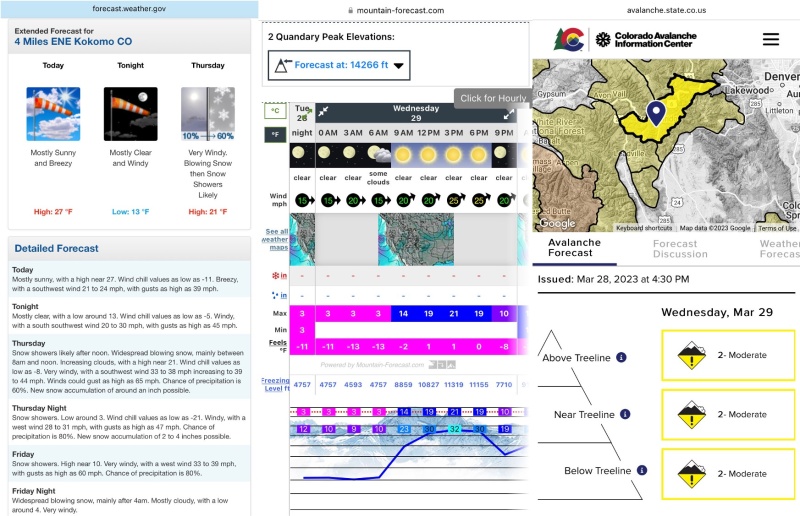
Quandary on my hike was "Mostly sunny with a high near 27F, wind chill values as low as -11F, breezy with a southwest wind 21 to 24 mph and wind gusts as high as 39 mph" with "Moderate Avalanche Risk". This was significantly better than the projected weather the day after, which included cold and very windy conditions with widespread blowing snow. I got lucky. The Quandary East Ridge (winter trail) is a steep, non-technical Class 1 trail with relatively low avalanche risk as 14ers go, which is why this trail is typically recommended as a first place to start. Quandary Peak also has excellent road access and winter parking, which means that the hike distance is equivalent to the summer trail (unlike most other 14ers in the state where the winter trailhead adds significant mileage to your day). Step 3. Hiking Below Treeline I was buzzing with excitement and apprehension when I pulled all of my gear together and headed out the door. I had five years of Upper Midwest cold weather experience, but no real understanding of what hiking a snow-covered 14er would be. Would I be able to summit? Would I encounter any problems that require an early turn-around? How many other hikers would be on the mountain if I encountered a problem? [SPOILER: Yes. No. 30+.] I hit the trail before sunrise, put on my snowshoes and started hiking up the snowy trail with poles in hand. Big thanks to High Alpine Sports in Fairplay, Colorado for the snowshoe and pole rentals. Conditions were pleasant at the trailhead (24°F) and wind was not a problem below treeline. Previous hikers had broken trail the previous couple days and Quandary already had a "mega-trench" in place, which greatly improved my below-treeline pace. Maintaining trail on Quandary Peak below treeline was not difficult, given the established trench. The snowshoes kept me afloat and I was able to get a rhythm with my poles and snowshoes and keep a steady progress. Without all of that prior traffic, breaking trail through the powder would have been a much more involved affair (i.e., hiking basically any Colorado 13er in March). 
Step 4. Hiking Above Treeline / Middle Ridge Once I cleared the treeline, the views and my exposure to the elements really opened up. Sunrise alone on a snowy mountain above treeline is a truly memorable experience. All at once, you feel awe, spender, isolation and anticipation for the new day. The higher I hiked on the ridge, the more steady the breeze became. Snow depth on the mountainside was much more variable, with some slopes scoured free of snow and others deep with fresh blown powder. For Quandary, when the sunlight finally cleared Hoosier Ridge to the east, the day immediately transitioned to the overwhelmingly bright conditions that I experienced the rest of the day. Goggles on! 
This section was a slow trek up to the intermediate flat on Quandary's East Ridge. It wasn't exactly difficult, but it was slow-going. 
Step 5. Summit Push Along the Exposed Ridge After reaching the intermediate flat, which is basically a prominent break in Quandary's slope more than half way up the mountain, I was able to catch my breath and admire the remaining ridgeline that stood before me. What remains is a little less than a mile of trail with 1000 feet of gain to reach the summit. The ridgeline is raw and exposed to the elements, but really only a steep Class 1 trail with no exposure. 
I would describe the summit push as a non-technical but unpleasant trudge to the top. Wind gusts in excess of 30 mph periodically blew around the mountain, pushing on my balance and blasting powder onto any exposed surfaces. At this point, I was completely covered up with my winter gear, which was the only thing that allowed me to complete this section of the hike. 
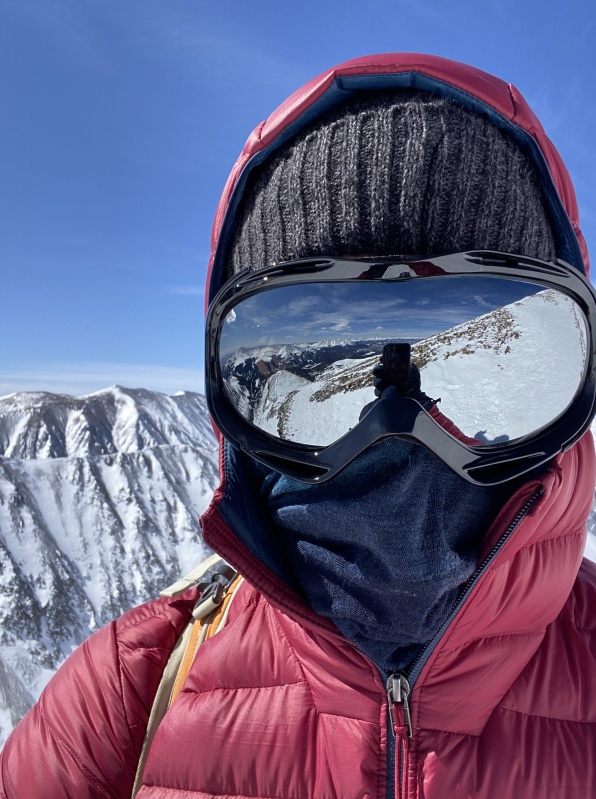
Why hike Quandary in the Early Spring? For the Chance to Summit Quandary Alone! Quandary Peak has a reputation for being one of the most crowded 14ers in the state. The summit is a narrow ridgeline that cannot comfortably accommodate the crowds that usually frequent it in warmer months. Many hikers report reaching the summit, but then lingering only long enough to snap some shots than then go. You don't summit Quandary for the backcountry experiences... However, hiking Quandary in the early spring with an early start can give you the opportunity to enjoy the summit all by yourself! It was such a decadent joy to spend time on the top and not have to share it with anyone. The views from Quandary are superb as you are smack in the middle of the Mosquito/Tenmile Range and you can see all the way to the Sawatch and Front Ranges. The winds also abated for a bit, so conditions for me on the summit were perfect. It was a beautiful solitude and an experience I will not soon forget. 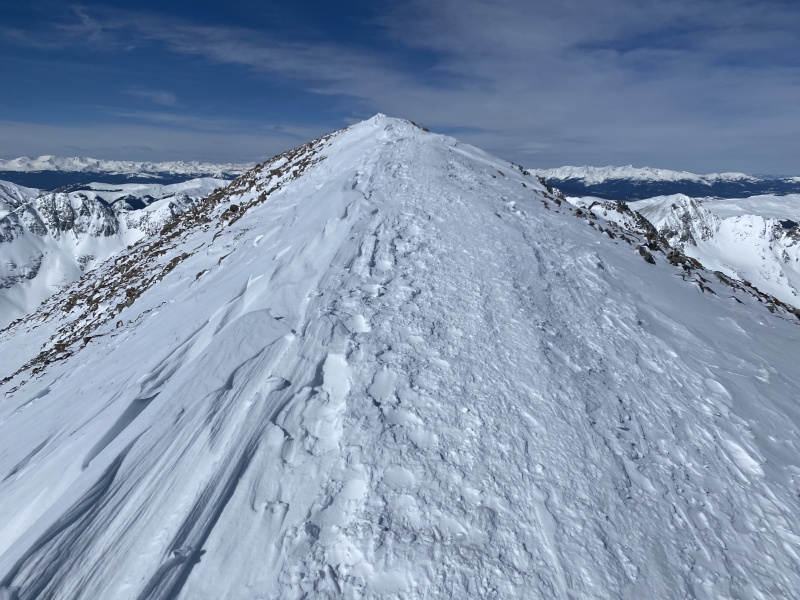
Hiking in the early spring also grants you a unique intermediate period where the weather conditions are improving, but the temperatures on the mountain are not so warm that you have to struggle with post-holing throughout the whole day. Recall that just a few weeks after my summit, soft snow along Quandary's Ridge was devouring unprepared hikers' shoes and necessitating the justifiable but ignominious calls to Colorado Search and Rescue. You must always have flotation available in the shoulder seasons for your own safety! 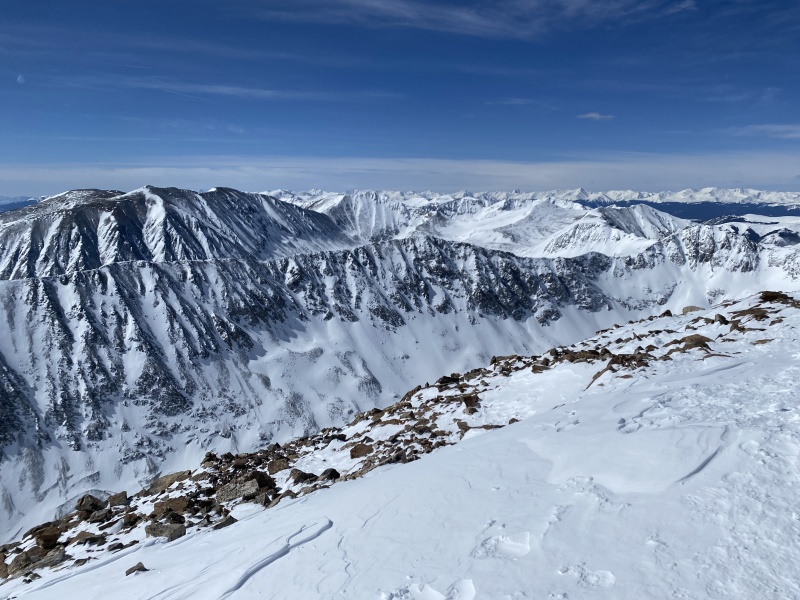
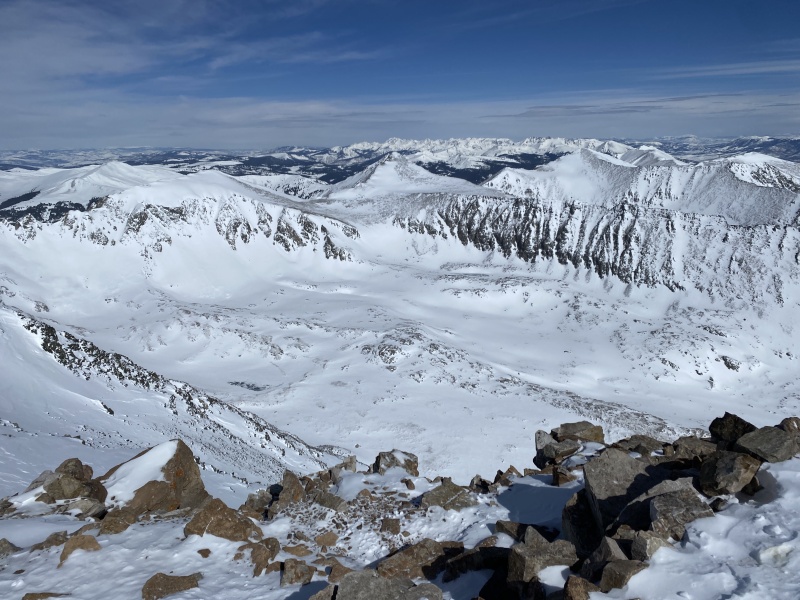
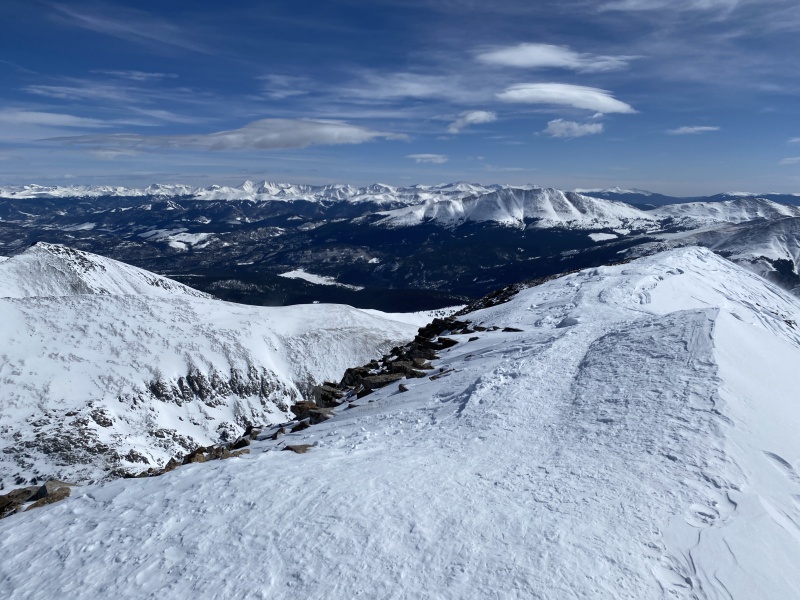
Return Trip / Getting Down to the Bottom The return trip to the trailhead is a long, bright, and slow slog, although I welcomed the faster pace than my ascent. The temperatures continued to increase throughout the day. While the summit was probably still in the mid-20s, the temperatures along middle ridge and below appear to have risen above freezing, which weakened the snow's strength and greatly increased the likelihood of post-holing. I wore my snowshoes the whole day, so was able to manage the softening snow. However, at least half of the hikers that I passed on my way down had no flotation whatsoever and were really starting to struggle. I can't stress enough that you must have the option of flotation on these slopes, not only for good experiences but also to avoid losing shoes, etc. I also started overheating on my descent with the warming temperatures, but was able to easily shed my layers and avoid excessive sweating. I think the goal on these hikes is to always be a little cold, but not excessively so. Overall, this early spring hike of Quandary Peak was an absolutely amazing experience. The hike is much more challenging than what you would experience in the summer, but it has much fewer people on the slopes and it grants you a real sense of accomplishment. In my opinion, this is the only way that you should hike Quandary Peak. |
| Comments or Questions |
|---|
|
|
Caution: The information contained in this report may not be accurate and should not be the only resource used in preparation for your climb. Failure to have the necessary experience, physical conditioning, supplies or equipment can result in injury or death. 14ers.com and the author(s) of this report provide no warranties, either express or implied, that the information provided is accurate or reliable. By using the information provided, you agree to indemnify and hold harmless 14ers.com and the report author(s) with respect to any claims and demands against them, including any attorney fees and expenses. Please read the 14ers.com Safety and Disclaimer pages for more information.
Please respect private property: 14ers.com supports the rights of private landowners to determine how and by whom their land will be used. In Colorado, it is your responsibility to determine if land is private and to obtain the appropriate permission before entering the property.
